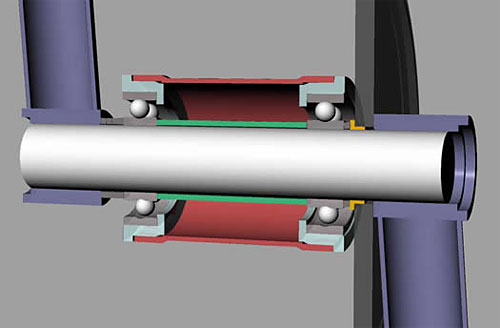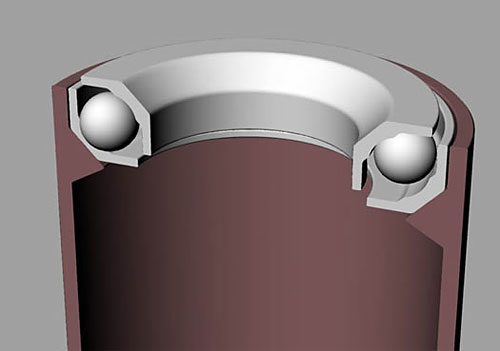"What tires are you running?" is a common question in all types of cycling. In BMX, we ride on widely varying terrain: smooth, slightly dusty concrete parks; rough asphalt roads; dusty, dry dirt; and even some rock infested trails. So which tires is best? In order to answer that, we have to look into what tires, compounds, and tread excel in which conditions.
Park: Smooth concrete, wood, metal
Taken from a simple perspective, the best grip at the park will come from the largest contact patch. So in a well cleaned park, treadless tires like the Primo Comet tend to work best. It's similar to car racing. The formula one cars zipping around at 200 mph do so on smooth tires. But as the conditions of the ground become more rough, or debris such as dust and water are introduced, the performance of smooth tires suffers.
When your car hydroplanes, it does so because the large contact patch of the tires distributes the weight well enough to not break the surface tension of the water it is resting on. This is where tread and narrower profiles come into play. Road bike tires are narrow enough that they slice down to the asphalt below. A similar thing happens with dust: the smaller the contact patch, the higher the pounds per square inch (psi) of pressure. Higher psi helps push the dust out of the way, getting down to the nicer ground.
Too much tread at the park can lead to an unstable contact with the ground. As one knob, or section of tread slips out of grip, the traction can suddenly change., which is never fun.
Street: a need for toughness
Two things happen when switching to street: the ground tends to be rougher and more diverse, calling for more aggressive tread than is necessary in park riding; and the rougher ledges and riding call for more sidewall toughness. I say toughness, because a stiffer sidewall is not necessary, just one that resists abrasion and tearing better.
Many "street" tires, like the legendary Primo Wall tires use heavy nylon sidewalls and casing. Although nylon provides good resistance to damage, it is relatively stiff, heavy, and has greater hysteresis (internal friction) than the Kevlar and cotton casing materials (at least in the low threads-per-inch count of many BMX tires).
Cotton is simply too easy to tear to use in a street tire. So a slight increase in hysteresis is necessary for the resilience of Kevlar casings. Perhaps this explains the long lifespan of Revenge Industries (S & M) tires. The low-profile, semi smooth tread, thin Kevlar casing, and now available in different sizes and with a folding (Aramid/Kevlar) bead make this tire a great choice for riders who find themselves riding street as much as park.
Dirt: where smooth tires hurt
I don't know about your trails, but all the ones around here (San Francisco) are covered in a layer of dust. As discussed earlier in this post, smooth tires are terrible in dusty conditions, they do not get down to the supportive ground underneath. This is why tread is the name of the game. How aggressive your tread is depends on the trails you're riding. If the dirt is relatively smooth, then a low/medium tread will give you the most solid feel (without the squirm-i-ness sometimes prevalent in higher knobs). As the terrain becomes more rocky and full of ruts and roots, you'll want to increase the tread. A tire like the Maxxis MaxxDaddy will give good grip in rougher terrain. But be warned, these tires have preferred channels to sit in when cornering. They will feel a bit on or off, but once you feel out where that channel is, you can rail any corner.
Some people, myself included, like to go with little grip in the back, but a nice grabby tire up front. This is because your front tire is leading, where it goes, everything else will want to follow. So if your front washes out, your down. But in the rear, it can be helpful to drift around corners, or slide the back when over rotating. The trick to making this work is to ride the front wheel. If you keep your back end light, you wont get sucked down when its sliding.
Summary
Tread:
None: Good for smooth, clean park riding, and some street applications
Little: More tolerant of contaminants and rough terrain, so it works better as an all-around tire
Medium: Grippy on rougher asphalt and dirt conditions
Tall/Heavy: Almost exclusive to Dirt riding as it may feel unstable on more consistent terrain.
I'd like to talk about
Durometer ratings, but only a few manufacturers provide ratings like
Maxxis. In general, lower durometer ratings (below 60) provide a softer feel, but wear away faster, while higher ratings (65+) are harder. Interestingly, Maxxis uses higher rated rubber in their higher tread models.
Casing Material:
Cotton: Common, cheap, light, and relatively low hysteresis (Dirt/Park)
Nylon: More common, cheaper, much better toughness, but heavier and higher hysteresis (Low cost Park/Street)
Kevlar: Some variety, higher cost, very good toughness, lighter and lower hysteresis than nylon (Park/Street)
Higher threads-per-inch casings provide lower hysteresis, a more comfortable feel, and good protection agains tears, but are generally more expensive. Most folding tires are higher TPI (120+), while steel beaded tires usually run lower (60-100), but again, few manufacturers specify what they use.
Bead (almost independent of riding style):
Steel: Very low cost, heavy, and stretches with higher inflation pressures
Aramid/Kevlar: Higher cost, significantly lighter and stiffer, and does not stretch
Inflation pressure (depends greatly upon tire):
Lower: tire forms over rough terrain better, feels less solid or like a rail, more likely to pinch flat, greater give when landing, higher rolling resistance, and more likely to blow off the rim
Medium: Good rolling resistance, good pinch resistance, fair impact absorption, and good traction and stiffness
High: Slightly less rolling resistance, rare for pinch flats, low impact absorption, poor traction over debris such as rocks, ok traction over dust and water (due to a smaller contact patch), feel much more like riding on rails
Further Reading:



![[forgeability+al+alloys.bmp]](https://blogger.googleusercontent.com/img/b/R29vZ2xl/AVvXsEhdoFMYrJsB-KM8qGywJ41gvARn1M9aZ_dyhQxLAkIesYXoWRMf5oxHvZnADkrRU4CN8j2nzuyivxi_1rdQNy7UQzRKKx1_jCw0UFtSK56i_PXB-JGu0flD2dXz4ybCNjlrZGfP0CiXpQB-/s1600/forgeability+al+alloys.bmp)

